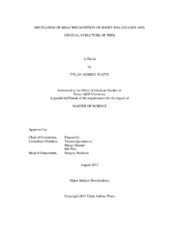| dc.contributor.advisor | Li, Pingwei | |
| dc.creator | Watts, Tylan Aubrey | |
| dc.date.accessioned | 2013-12-16T19:56:38Z | |
| dc.date.available | 2015-08-01T05:48:24Z | |
| dc.date.created | 2013-08 | |
| dc.date.issued | 2013-05-16 | |
| dc.date.submitted | August 2013 | |
| dc.identifier.uri | https://hdl.handle.net/1969.1/150979 | |
| dc.description.abstract | The innate immune pathways that stimulate the expression of cytokines and proapoptotic factors in response to infection are triggered by the activation of the cytosolic receptors retinoic acid-inducible gene I (RIG-I) and melanoma differentiationassociated gene 5 (MDA5). Activation of both receptors occurs as a result of binding to RNA. MDA5 only recognizes double stranded forms of RNA, whereas RIG-I is capable of recognizing both single and double stranded RNA. In vivo, MDA5 is known to be stimulated by long (>1 kb) strands of RNA, forming filaments along the phosphate backbone. However, the manner in which MDA5 can recognize the terminal end of its RNA ligand is uncertain.
I have examined the mechanism of binding of the MDA5 protein by comparing MDA5 binding to short (<18 bp) blunt RNA, 5’ triphosphate RNA, and RNA with a 3’ or 5’ overhang. It is shown that while the MDA5 protein regulatory domain (RD) is essential for RNA recognition, the MDA5 RD only weakly recognizes short double stranded RNA ligands with overhangs or a 5’ triphosphate group. The Cys951 residue was shown to disrupt stability of the MDA5 RD-RNA complex. Binding analyses were performed using a combination of SDS-PAGE, gel filtration analysis, and nondenaturing gel electrophoresis. In addition, structural data was gathered by crystallization of the MDA5 RD-RNA complex using X-ray crystallography. These results help to establish the manner in which MDA5 is regulated predominantly to the binding of long RNA ligands.
Also included in this document is structural data on the dimer form of the PepQ protein from E. coli. PepQ is a highly conserved proline peptidase that has a secondary activity of hydrolyzing organophosphorus triesters, toxic compounds found in many pesticides. The PepQ protein was crystallized and analyzed by X-ray diffraction. The dimer interface was clearly defined within the structure and provides insight into how the active dimer forms from the PepQ monomer. | en |
| dc.format.mimetype | application/pdf | |
| dc.language.iso | en | |
| dc.subject | melanoma differentiation-associated gene 5 | en |
| dc.subject | MDA5 | en |
| dc.subject | RIG-I-like receptor | en |
| dc.subject | RLR | en |
| dc.subject | proline peptidase | en |
| dc.subject | PepQ | en |
| dc.subject | ribonucleic acid | en |
| dc.subject | RNA | en |
| dc.subject | X-ray crystallography | en |
| dc.subject | protein binding | en |
| dc.subject | RNA binding | en |
| dc.subject | crystal structure | en |
| dc.title | Mechanism of MDA5 Recognition of Short RNA Ligands and Crystal Structure of PepQ | en |
| dc.type | Thesis | en |
| thesis.degree.department | Biochemistry and Biophysics | en |
| thesis.degree.discipline | Biochemistry | en |
| thesis.degree.grantor | Texas A & M University | en |
| thesis.degree.name | Master of Science | en |
| thesis.degree.level | Masters | en |
| dc.contributor.committeeMember | Glasner, Margaret E | |
| dc.contributor.committeeMember | Igumenova, Tatyana | |
| dc.contributor.committeeMember | Park, William | |
| dc.type.material | text | en |
| dc.date.updated | 2013-12-16T19:56:38Z | |
| local.embargo.terms | 2015-08-01 | |



